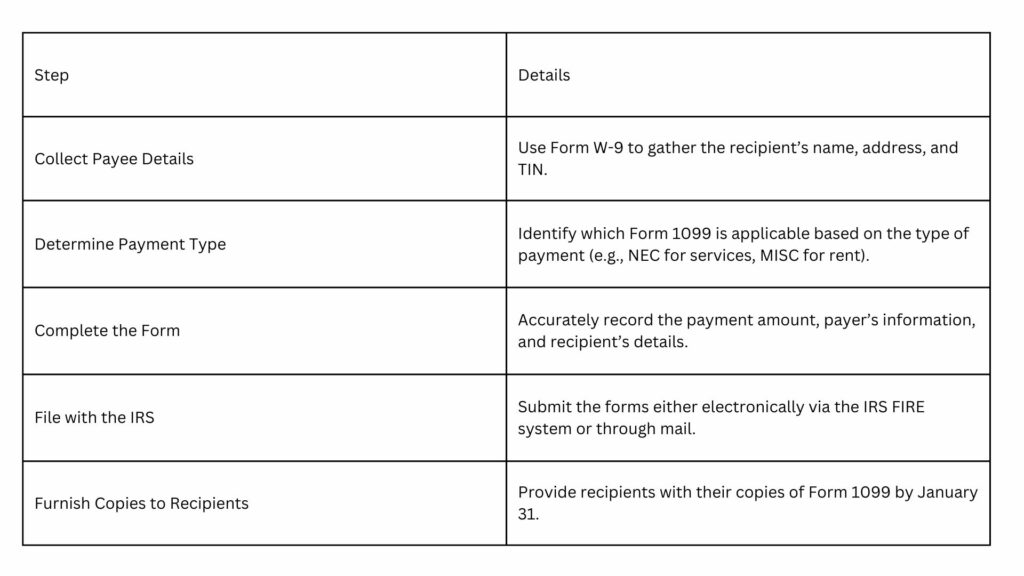The IRS issues Form 1099, a key tax document that reports different kinds of non-employee income. This form helps keep income reporting clear for individuals and businesses, and it’s vital to the U.S. tax system. Businesses use Form 1099 when they pay an individual who isn’t their employee.
Businesses should know the ins and outs of Form 1099 if they work with freelancers, independent contractors, or other non-employee service providers. This article gives you a full rundown on Form 1099: what it is, its types, how to file it, and how businesses and those who get the form can handle their taxes the right way.
Overview of Form 1099
Form 1099 is labelled as an “information return.” It is designed to help the IRS track taxable income that may otherwise go unreported.
The purpose of Form 1099 is to ensure that individuals who earn non-wage income accurately report it on their tax returns. For businesses, issuing Form 1099 is not just a compliance requirement but also a way to maintain transparent financial practices.
Who Must File Form 1099?
Usually, any individual is not responsible for filing Form 1099 as the businesses that make the payment will issue it.
Any business or organization that makes qualifying payments of US$600 or more to a non-employee within a calendar year is required to file a Form 1099.
These payments can include fees, commissions, rents, royalties, and prizes, among others. Banks and even investment firms have to file Form 1099 if they pay dividends or interest.
Who Receives Form 1099?
Recipients of Form 1099 include independent contractors, freelancers, consultants, and other non-employees. Examples include:
- A graphic designer hired on a project basis.
- A landlord receiving rental income.
- A freelance writer paid for articles.
The recipients are responsible for reporting this income on their tax returns, regardless of whether taxes were withheld.
Common Types of 1099 Forms
The IRS has provided various versions of Form 1099 for different types of income. Let’s look at the common types of 1099 forms:
Form 1099-NEC (Nonemployee Compensation)
- Purpose: Used to report payments of $600 or more made to non-employees for services rendered. Businesses that deal with independent contractors often use this form.
- Examples of Applicable Payments: Fees paid to contractors, sole proprietors, consultants, or freelancers.
- Filing Deadline: Form 1099-NEC must be filed with the IRS by January 31.
- Form 1099-NEC: https://www.irs.gov/pub/irs-pdf/f1099nec.pdf
Form 1099-MISC (Miscellaneous Income)
- Purpose: This form is used to report a few specific miscellaneous compensations and essentially covers payments not reported on Form 1099-NEC.
- Examples of Applicable Payments:
- Rent payments.
- Healthcare payments.
- Royalties exceeding US$10.
- Payments to attorneys.
- Filing Deadline: The deadline for filing Form 1099-MISC is February 28 (March 31 if reporting electronically) for the IRS.
- Form 1099-MISC: https://www.irs.gov/pub/irs-pdf/f1099msc.pdf
Form 1099-K (Payment Card and Third-Party Network Transactions)
- Purpose: This form reports transactions made through third-party payment processors, debit cards, credit cards, gift cards, or online marketplaces.
- Examples: Income earned from online marketplaces or gig platforms.
- Filing Deadline: You must note that the deadline to file Form 1099-K with the IRS for payment companies and third-party payment apps is January 31. They must also send you a copy of the same by January 31.
- Form 1099-K: https://www.irs.gov/pub/irs-pdf/f1099k.pdf
Other Notable Forms
- Form 1099-INT: For interest income from checking or savings accounts exceeding $10.
- Form 1099-DIV: For dividends and investment distributions from mutual funds or stocks.
- Form 1099-R: For distributions from pensions, retirement accounts, or annuities.
Deadlines and Penalties for Form 1099
In this section, let’s discuss the key deadlines and penalties related to Form 1099:
Key Deadlines for 1099 forms
- January 31: Deadline to furnish Forms 1099-NEC and 1099-MISC to recipients. Deadline for filing paper copies of Form 1099-NEC with the IRS.
- February 28: Deadline for filing paper copies of Form 1099-MISC with the IRS.
- March 31: Deadline for electronic filing with the IRS.
Penalties for Non-Compliance
Failing to meet these deadlines can result in penalties ranging from US$50 to US$660 per form, depending on the lateness of the filing.
Information Collection
Collecting accurate payee information is crucial. Businesses must use Form W-9 to gather a contractor’s name, address, and Taxpayer Identification Number (TIN). Failure to collect accurate information could lead to IRS audits or penalties.
How to Prepare and File 1099 Forms?
In this section, let’s discuss the steps for Preparing Form 1099:
Filing Methods
- Electronic Filing: Businesses can file electronically through the IRS Filing Information Returns Electronically (FIRE) system. This method is faster, more efficient, and reduces the likelihood of errors.
- Paper Filing: For businesses filing fewer than 250 forms, paper submission is permitted. Be sure to mail forms to the correct IRS processing center.
Payment of Taxes Associated with 1099 Forms
- Recipient’s Responsibility: Income reported on Form 1099 must be included on the recipient’s tax return.
- Backup Withholding: If the payee fails to provide a valid TIN, the payer may be required to withhold 24% of the payment as backup withholding.
Conclusion
Form 1099 is a cornerstone of the U.S. tax system as it ensures transparency and compliance for non-employee income. For businesses, issuing these forms accurately and on time is not just a legal requirement but also a best practice for maintaining financial transparency.
By understanding the different types of 1099 forms, filing requirements, and preparation steps, businesses can avoid penalties and develop trust with their contractors and the IRS.
To know more about filing Form 1099, consider GJM & Co. We offer comprehensive services related to accounting and bookkeeping, taxation, payroll accounting, payroll management, Business Formation, Virtual CFO, and more. Get in touch with us via info@gjmco.com or schedule a call.

